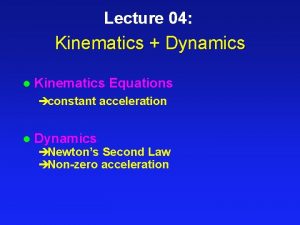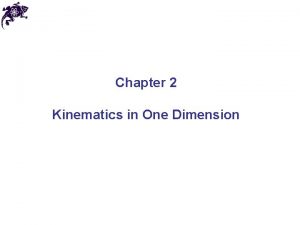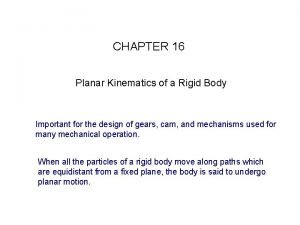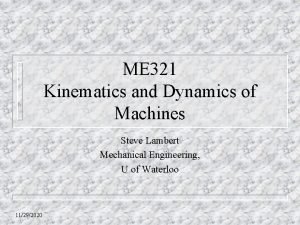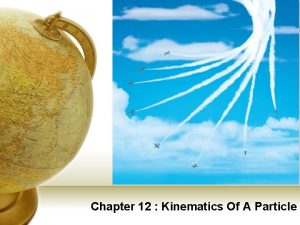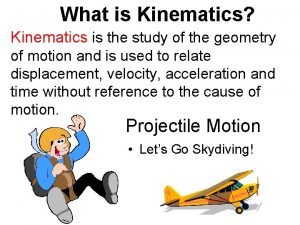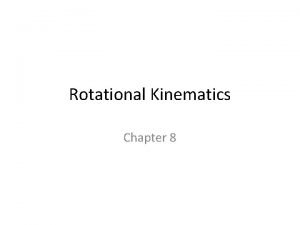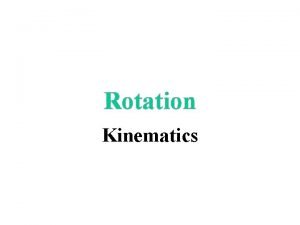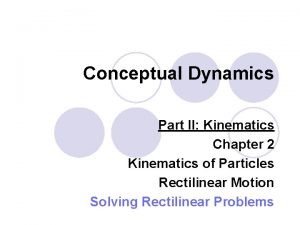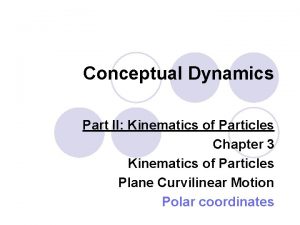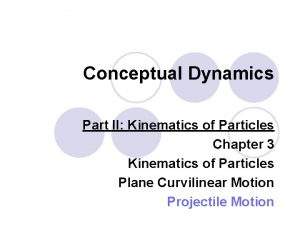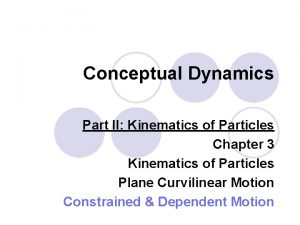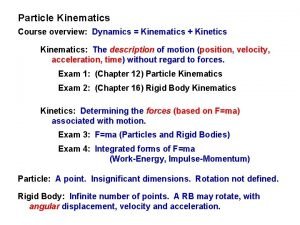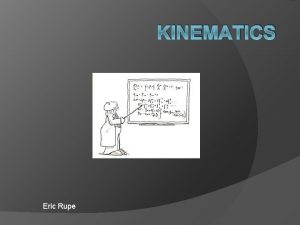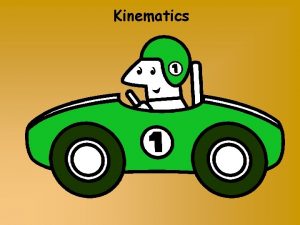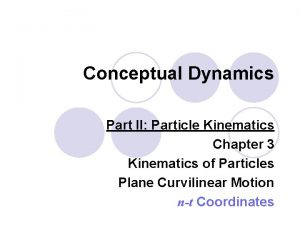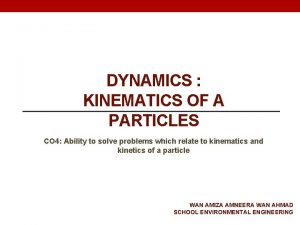Conceptual Dynamics Part II Kinematics of Particles Chapter





















- Slides: 21

Conceptual Dynamics Part II: Kinematics of Particles Chapter 3 Kinematics of Particles Plane Curvilinear Motion Relative Motion

Introduction l Hybrid vs. sports car ¡Sometimes it is useful to describe the motion of one object relative to another

Reference Frame Definitions

Reference Frames l Inertial Reference Frame ¡ Non-accelerating which implies non-rotating ¡ We will also assume nonmoving l Non-Inertial Reference Frame ¡ Accelerating and may also rotate l Body-fixed Reference Frame ¡ Fixed to a usually moving body

Reference Frames l Position, velocity and acceleration can be described in terms of; ¡Inertial coordinates ¡Body-fixed coordinates

Absolute and Relative Motion

Relative Position l What is the difference between absolute position and relative position? ¡Absolute?

Relative Position l What is the difference between absolute position and relative position? (absolute) Absolute positions are measured from a stationary coordinate system (inertial). r. A = Absolute position vector of particle A. r. B = Absolute position vector of particle B.

Relative Position l What is the difference between absolute position and relative position? ¡Relative?

Relative Position l What is the difference between absolute position and relative position? (relative) Relative positions are usually measured from another moving particle (moving coor. system). r. A/B = Relative position vector of particle A with respect to particle B.

Relative Position l Through vector addition we can relate absolute and relative positions. What is r. A?

Relative Position l Through vector addition we can relate absolute and relative positions. What is r. A?

Relative Velocity l Velocity is the time rate of change of position.

Relative Acceleration l Acceleration is the time rate of change of velocity.

Important Equations l Therefore,

Conceptual Example 3. 6 -1 l Consider a train moving along a track. The speed of the train is given in the figure. A person is walking inside the train in the direction shown with the speed shown relative to the train.

Conceptual Example 3. 6 -1 l A stationary observer watches the walking person. In which situation does the person walking inside the train appear to the stationary observer to be walking the fastest to the stationary observer and which is the slowest?

Fastest ___ Next ___ Slowest ___

D Slowest ___ A C Next ___ B Next ___ Fastest ___

Relative Velocity l Video ¡Common Physics Misconceptions

Example Problems EP 3. 6 -2 EP 3. 6 -3
 Aplusphysics kinematics-horizontal kinematics
Aplusphysics kinematics-horizontal kinematics Dynamics vs kinematics
Dynamics vs kinematics Dynamics kinematics
Dynamics kinematics Rigid body
Rigid body Kinematics and dynamics of machines
Kinematics and dynamics of machines Dynamics of particles
Dynamics of particles Dynamics of particles
Dynamics of particles Fluid mechanics chapter 4
Fluid mechanics chapter 4 Chapter 12 kinematics of a particle solutions
Chapter 12 kinematics of a particle solutions Chapter 6 ions charged particles in solution
Chapter 6 ions charged particles in solution Part whole model subtraction
Part whole model subtraction Unit ratio definition
Unit ratio definition Brainpop ratios
Brainpop ratios Technical object description example
Technical object description example Parts of a bar counter
Parts of a bar counter The phase of the moon you see depends on ______.
The phase of the moon you see depends on ______. Minitab adalah
Minitab adalah Differential drive inverse kinematics
Differential drive inverse kinematics What is kinematics
What is kinematics Sin 37
Sin 37 Rotational motion equations
Rotational motion equations Rotational kinematic equations
Rotational kinematic equations

